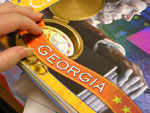Friends of Jefferson Patterson [MD]
Jefferson Patterson Park and Museum (JPPM) is the state archeological museum of Maryland and is located on 560 scenic acres along the Patuxent River in Calvert County, Maryland. JPPM is home to the Maryland Archaeological Conservation Laboratory, which houses over 8 million artifacts which are available for research, education, and exhibit purposes to students, scholars, museum curators, and educators. JPPM is also a vibrant center for education.
School groups learn about Native American and Colonial history and archaeology. Visitors enjoy workshops on pottery, basketry, carving or sewing, talks about the history of the Chesapeake Bay region, or exhibits “FAQ Archaeology” and "The War of 1812." Behind the scenes tours of the Maryland Archaeological Conservation Laboratory show how artifacts are treated and studied. Maryland educators can rent a 4th-grade travelling trunk on Eastern Woodland Indian Cultures. Downloadable teacher resources, including pre- and post-visit activities, are available on the museum's website.
